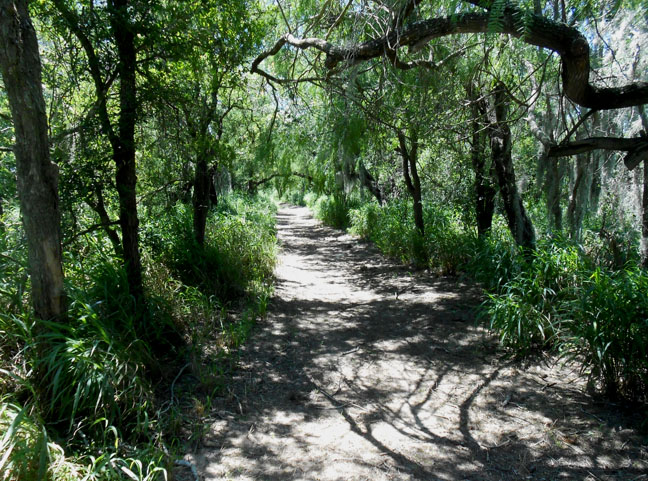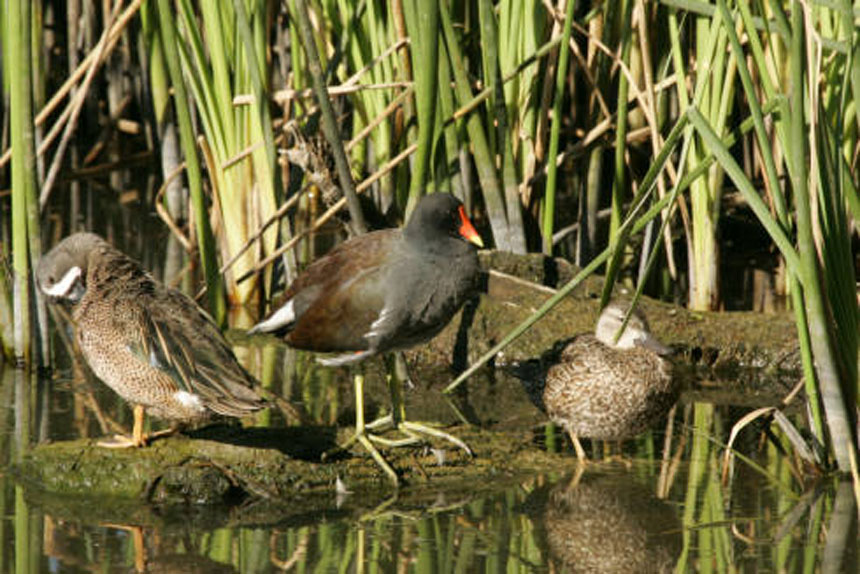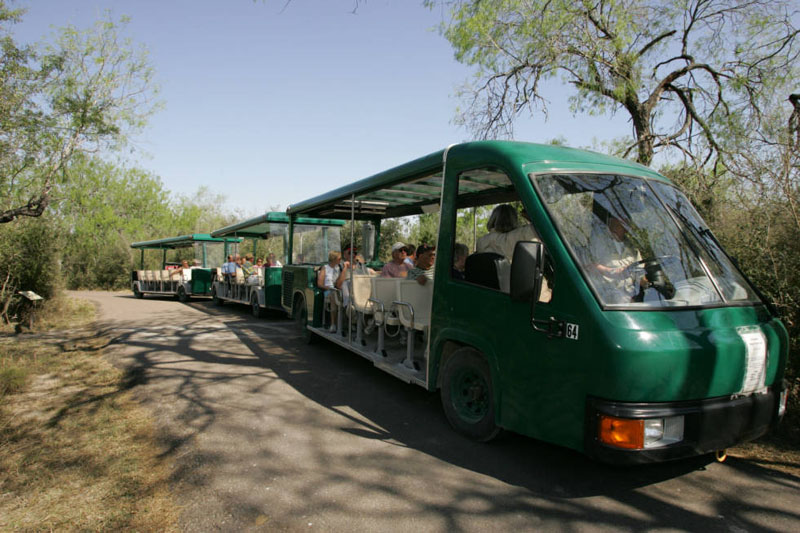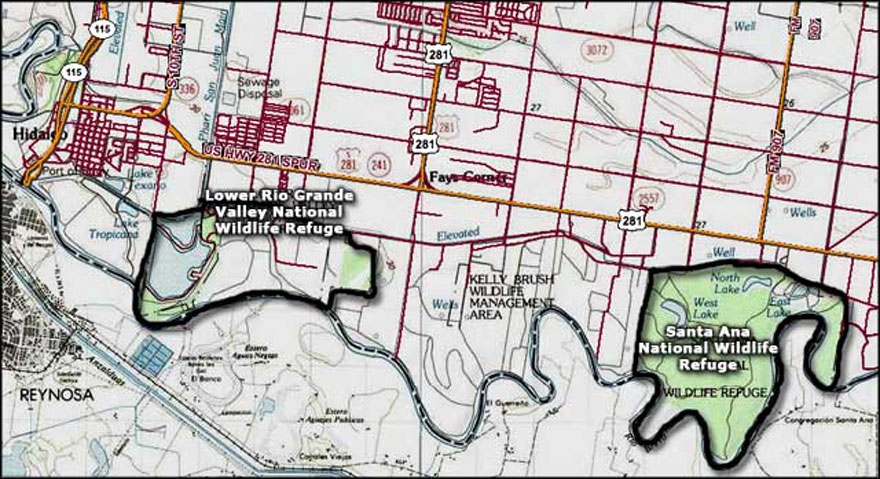The Santa Ana National Wildlife Refuge in the Lower Rio Grande Valley (LRGV) of Texas is under assault. The U.S. Army Corps of Engineers and its contractors have been taking soil samples, surveying portions of the refuge, and making other preparations in and around the refuge to build a huge and intrusive border wall. Apparently, work has been ongoing on the refuge for several months, but nothing was said to the public, until information leaked earlier this month.
We are taking action on this issue, as are many other groups. We ask that you help (see the end of this article).
 |
|
 |
Photo: USFWS |
Santa Ana NWR protects 2,088 acres of unique habitat along the banks of the Rio Grande. The refuge was originally created in 1943 to protect migratory birds, and fully 94.9% of its property has been acquired through Stamp/MBCF dollars. The refuge rests on vital land, and it is estimated only 5% of the native landscape still exists in the LRGV.
The refuge is home or a crucial stopover site for some 400 bird species that have been seen there, including migratory waterfowl, raptors, warblers, and a suite of "South Texas specialties" that are Mexican in character and barely range into Texas. Other wildlife species – from rare mammals to herps and butterflies – call the area home. Moreover, Santa Ana NWR is central to a complex of natural hotspots in The Valley that draws county-level economic income of over $465 million per year and accounts for 7,000 jobs from eco-tourists and avi-tourists in the four-county region along the Rio Grande.
An estimated 95% of the land on the Mexico border in Texas is privately owned. By starting the border-wall in the Santa Ana NWR, the Trump Administration wishes to avoid the logistical predicament of working with private landowners to build a wall in their backyards.
|
|
 |
| Photo: USFWS |
 |
The Administration is also aiming to use the REAL ID Act of 2005 to bypass environmental protections and processes that would normally be applied to a construction project of this nature. Standard environmental and wildlife laws like the National Environmental Policy Act, the Endangered Species Act, the Migratory Bird Treaty Act, and the National Wildlife Refuge System Improvement Act would be bypassed to expedite construction.
If the border wall through Santa Ana NWR gets a free pass, planned as it is through the elevated border levee (under the jurisdiction of the International Boundary and Water Commission) that traverses the refuge, then nearby properties up- and downriver for at least 25 miles are at risk. The plans include a totally cleared buffer zone of 50 yards (including a service road) on the south side of the wall. Sections of the proposed wall will also impact parcels of the associated Lower Rio Grande National Wildlife Refuge, and even Texas state properties (such as Bentsen-Rio Grande State Park) and county properties, as well as private properties along what is generally considered to be a broad wildlife corridor.
The National Wildlife Refuge System and our border refuges should not be splintered up simply because the land is owned by the federal government. These lands have been preserved for solid wildlife management reasons, and it is unconscionable that this Administration would consider building a wall through these lands without serious public process or discussion.
A serious investigation on the long-term biological and economic impacts of the border wall in this area is in order, including the impact on the refuges, other public lands, and adjacent properties. The current plans at Santa Ana are not only an assault on a much-beloved NWR, they constitute a taking of Stamp-invested property. Therefore, included in any assessment should be a compensation element, enough to make the area biologically productive, commensurate with the investments already made over the years at Santa Ana and Lower Rio Grande National Wildlife Refuges. Beyond that, compensation made to the Migratory Bird Conservation Fund (where Duck Stamp dollars are deposited) is also justified.
Security along the border, of course, is important, and some wildlife-compatible fencing is justified. Still, the currently suggested wall and accompanying south-side cleared buffer may not actually contribute to security. There are probably better ways to address the issue under these circumstances; USFWS Law Enforcement could be enhanced for all parcels of the Refuge System in the LRGV.
Unfortunately, the plans are proceeding in this area without asking for input from the very people who ought to have priority – American citizens, taxpayers, Duck Stamp buyers, community stakeholders, and users.
Texas Senator John Cornyn (R) has remarked on this environmentally sensitive issue that it is "imperative for federal officials to consult with local leaders on what the appropriate solutions might look like." He added that a physical border wall "is only a piece of the puzzle" and that "it may well be that rather than a physical wall in some of these places that technology will allow the Border Patrol to do its job just as effectively."
Nonetheless, the current Administration seems to be advancing with this ill-advised border wall despite objections.
You can express your opinions and access a model letter to reach Congress on this important issue from the National Wildlife Refuge Association, a model you are encouraged to edit to indicate your own specific concerns.
|
|
| On this map, you can see how some immediate properties upriver from Santa Ana NWR connect with the refuge. Implications for other properties – some many miles upriver and downriver – are considerable. Any planned wall construction on the levee – marked as "Elevated" here and at some places a mile or more inside the U.S. – almost serves to relinquish territory southward between the levee/border wall and the river. |
A version of this post first appeared in the 27 July 2017 issue of Wingtips.



